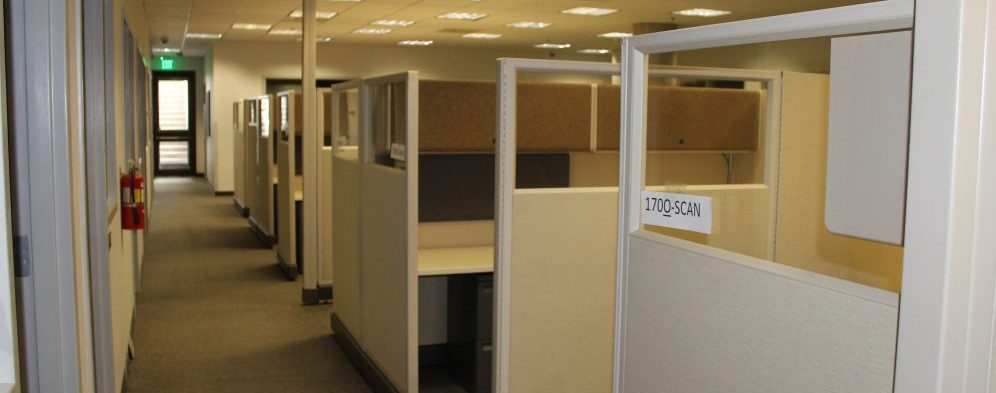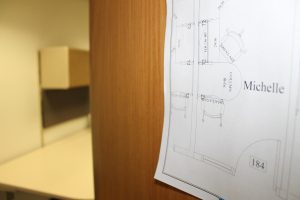
By Liz Ivkovich, Sustainability Office.
The University saved more than $120,000 by sharing office furniture between departments.
With the University’s exponential growth, campus departments expand accordingly. When they get too big for their old spaces they may move around campus in search of a better fit. Despite the best efforts of the University to reuse and resell, limited storage and varying furniture needs sometimes make it impossible to keep existing furniture. So, what happens next?
Staff members from University Hospital Information Technology Services and Procurement and Contracting Services (otherwise known as Purchasing) found one answer: sharing furniture across departments, giving a new life to existing cubicles, and saving the University $120,000.
Glendon Mitchell, director of Procurement and Contracting Services, is excited about this accomplishment.
“We think this is such a huge win for the University that hopefully can be repeated in the future,” he said. “It was a significant cost savings for the University, and environmentally, we were able to repurpose two complete suites of furniture that probably would have ended up in the landfill.”

When University Hospital Information Technology Services planned its move from 650 Komas to a new space, the existing systems furniture of cubicle units, prefab walls, and desk attachments was not going to be able to come along. Alison Plummer, architectural project manager for University of Utah Health Sciences, was tasked to get rid of it.
University Surplus & Salvage, which stores and sells surplus furniture, did not have space to store the more than 80 cubicles worth of furniture. Frustrated by the waste and cost to disassemble, recycle, and landfill the old furniture system, Plummer went on the hunt for a more sustainable alternative.
Meanwhile, across campus, Procurement and Contracting Services was moving in with P Card and U Shop staff in the basement of the Park building. The existing furniture in their new space did not provide adequate privacy for the sensitive nature of their work. These 33 staff would need new cubicles, a projected cost of $125,000–$150,000.
Michelle Entwistle, buyer for Procurement and Contracting Services, was working on the Park building move when she got a call from Plummer. Plummer asked Entwistle if there was a process or procedure Hospital Information Technology Services should follow to remove and recycle their furniture. “There are no rules or guidelines,” Entwhistle replied. “But we’re moving, and we need the furniture!”
A uniquely large-scale furniture transfer was born.
“It was a perfect alignment of conversation and timing,” Entwistle commented.
Entwistle connected with Evelyn Garlington, associate director for Space Planning & Management, to help with the logistics. Garlington and the rest of the Space Planning team coordinate all moves on lower campus, drawing plans and supporting the move process, including by helping departments to obtain and arrange the furniture they need.
When departments move around campus, Space Planning’s first stop is to reuse or repurpose. But systems furniture on this scale is a difficult proposition. In addition to the storage space required, these systems are very difficult to reassemble.
“Once you take the furniture down, and it’s stacked up and stored in hundreds of parts and pieces, it becomes problematic to figure out how to put it back together,” Garlington explained.

Despite these challenges, Garlington, Mitchell, Entwistle, and Plummer worked together to the make the furniture transfer happen. They contracted systems furniture experts Utah Office Planning to move, clean, and reassemble the furniture in the Park building. They also sold additional items that couldn’t be used.
“Nothing went to waste,” Garlington said.
After all the math is said and done, the University saved at least $120,000 through the combined efforts of Plummer, Entwistle, Mitchell, and Garlington.
Mitchell credits teamwork for this sustainability success, especially the support of Vice President for Administrative Services John Nixon, and Associate Vice President of Financial and Business Services Jeffrey West.
“Everyone on the team was really committed to this project. Michelle and Alison made the connection, Evelyn and Space Planning helped us plan it, and John Nixon and Jeff West gave us the green light and the funding to make it happen,” Mitchell concluded.
We love to tell these kind of sustainability success stories. If you or your team have a win to share, contact Liz Ivkovich at liz.ivkovich@utah.edu.
